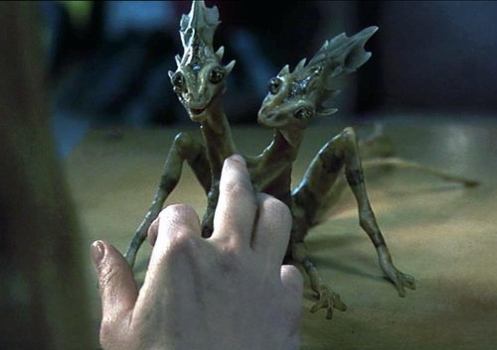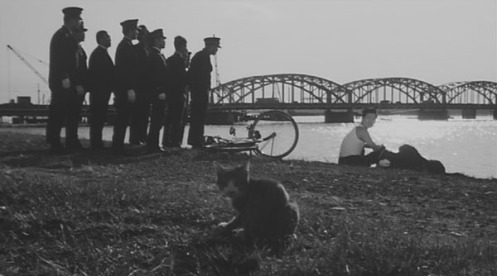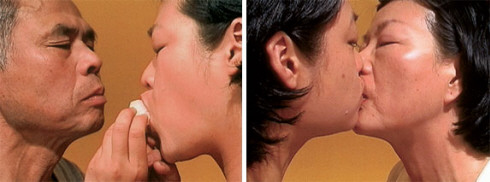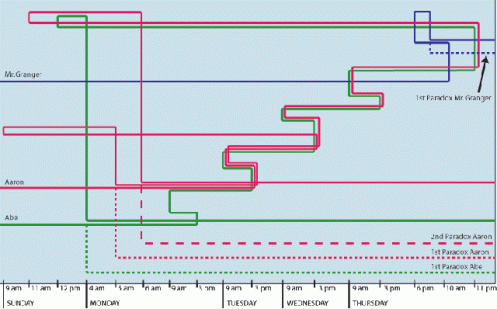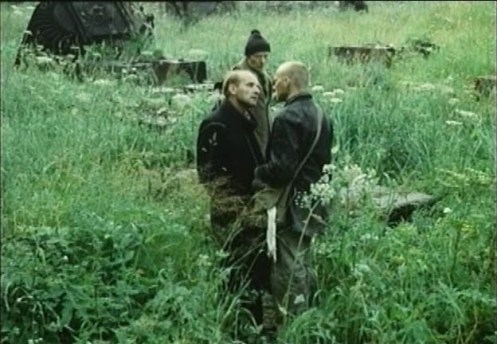Towards a Cinema of Affects: A Manifesto, Part II – Characters, Objects, Plots, Settings
[for part one, see here.]
POST-MODERN AFFECTIVITY
What is the relation of film to our contemporary age? We live in a world today in which our affects, namely, our thoughts and emotions, whether caused from within our without, no longer correspond to the classical unities of the past. No longer do we feel like unified subjects, no longer do we chase unified objects, or act in unified plots or in unified settings. Rather, these are all shattered, and recomposed in new transvidual composites, the logics of which we are only beginning to understand. We need a cinema that can give use affects to match those we experience in our times, and to help us imagine film-worlds which can help point the way, which can help us orient in our actual life-worlds.
Science-fiction films, films of madness, amnesia, horror, dreams, drug-states, and time-travel, all these films have lead the way. They have given us the films that best capture the affective states relevant to our postmodern times. And yet, they so often seem to need to justify the structures whereby they produce these affects with tropes such as high-tech machines that allow time travel, or magical portals, or ‘it was just a dream’. These films have pushed the traditional plots to their breaking points, and yet, often feel the need to recapture what they have shown us within something that can reconnect with more traditional film-logics. But what if we made films that directly attempted to speak to the affects relevant to our age, without having to justify themselves via reasonings tied to the limitations of the ‘real world’? Or what if we at least gave ourselves the option?
A film-world does not need to follow the limitations of the world, and it can impact this world even if it does not share these limitations. The history of film is full of examples of powerful films that dispense with aspects of the real world. Why not aim to produce affects directly, and structure films around them, rather than only producing them openly when we can justify a link to ‘the real world’? The cinema of affects does not need to imagine it is inside the mind of a mad person to produce a cinema like madness, or to imagine there are time travel machines to produce a cinema like time-travel. For to live in the world today, to hope and dream and remember, is already a form of time travel, a form of madness, it feels like this, and we can think these sensations even without the scaffolding provided by plot devices like madness or time-travel machines. Which is not to denigrate such films, for they are those which speak to us now most powerfully. But we need to learn from these films, and not be limited by the aspects of them which are swiftly seeming out of sync with the needs of the times.
Some have decried the first stirrings of the cinema of affects, the loose character formations, dissociated settings, and plots ever more baroque, as precisely that which should be resisted. And yet often these films speak more truthfully to the needs of our age than those films of the so-called ‘real world.’ Isn’t film supposed to speak to the world we live in, rather that of the past?
Take a film such as Christopher Nolan’s Memento (2000). Is not the short-term memory loss of the protagonist not an incredibly apt metaphor for what it feels like to live in our post-modern age? And yet, rather than decry the death of memory, we need to wonder, why might it not be possible to find a love, a poetry, within such a world. The protagonist in Memento learns in the end to gain agency over his seeming powerlessness, but does so in a brutal manner. But might it not also be possible to find a way to love in such a situation as well? Rather than yearn for the past, might it not be possible to wonder if there might not be room for new forms of goodness and love in such a world? And might not film be able to begin to show us how this could be possible?
CHARACTER
Too long film has been held hostage by the notion of the character, and the main character, or protagonist, in particular. This is not to say that film does not often become more powerful when it is focused by means of a unifying perspective, a single film-consciousness that serves as a tour guide through the film-world being portrayed. Alternately, a few such perspectives, or a series thereof, may serve as a focusing device. However, these tropes should be seen as means, not ends in themselves.
While a unifying perspective of some sort is often helpful in promoting identifications of various sorts, and for unifying the filmic experience, it is important to keep in mind that these functions do not need to necessarily be anchored to a character that resembles a person in the so-called ‘real world’. Why does our protagonist always need to wear the same face? Be played by the same actor? Have the same voice? Use the same name? Live in the same house? Work at the same job? Have the same set of memories, or the same set of character traits or dispositions for dealing with the world?
A character in a film is not a person in real life. A character is a means for creating a unifying perspective in a film which can orient the viewer and potentially serve as a site for potential identifications of varying sorts. A character is a function, composed of a set of variables, such as a name, a face, a voice, a point of view, a set of actions, a set of memories, each of which can remain static or change over the course of a film. In traditional cinema, a unifying perspective is always tied to the same body, voice, set of dispositions, memories, etc. In the cinema of affects, however, these all may be varied, associated or dissociated, depending upon the film-world in question.
For example, imagine two characters lying in bed with each other, making love. When they cease, and begin to speak again, we realize that they have switched names. And as they rise from the bed, they put on each others clothes. They go to each others jobs, and seem to have switched roles in life. Why is this not a possibility for cinema? It speaks to us emotionally, and we can make sense of it intellectually in a wide variety of ways, even as we realize our world does not work like this. But this does not mean we cannot be powerfully transformed by having seen such a film.
The question shouldn’t be if it is realistic that people can switch like this, but rather, what it makes us think or feel, and how this resonates with aspects of the world beyond the film. So-called ‘realism,’ the ‘reality’ that resonates with a dominant image of the world, is only useful to film to the extent that it serves the production of affects. For the goal of cinema is not to reproduce the world, but to affect us. This has always been the case, and while the cinema of affects may choose at times to harmonize with dominant notions of ‘reality’ when it serves its needs, it also must free itself from thinking it must follow so-called realism simply because it must.
Otherwordly and semi-worldly art and theory have been incredibly powerful throughout history. The history of religions and ideologies, arts and philosophies, all this is evidence enough. Why should film do any less? No painting has ever been true, nor any novel or film. The desire to make film true is the only way to make it lie.
Likewise, the only way to make a true film today is to make it deviate from the traditional notion of the character. For example, so many of the powerful films produced today have characters which are multiple sides of the same character, shattered in fragments. A film like Death by Hanging (1967), by Nagisa Oshima, is a clear precursor of this notion. Oshima fragments the general psyche of the post-war Japanese nation into an ensemble cast so he can play the parts off each other. A character has amnesia, the others try to restore his memory by teaching him about his past, they enact it, but find they eventually need his help, the scene degrades into parody, others from outside are recruited, but then reenacting violence leads to real violence. The whole troupe shifts locations as if transported through space and time into the streets of Tokyo, onto the top of a building, then back indoors where they started. Some now see a murdered woman, others don’t, then some that didn’t originally see her begin to. She starts out as a victim of murder, but then she wakes up, and begins to call the protagonist brother, but why then does she act as if she wants to make out with him? If one tries to make sense of the film as one of madness, it is impossible to tell exactly who is mad, or perhaps if what we are seeing is some sort of collective, transindividual madness. But why then would they all have such an odd hallucination? And why do so many of them act so strangely, hyperbolically, as if parodying themselves?
Only as the fragmented shards of the Japanese national psyche dealing with the guilt and fear and recriminations and denail of the post-war period can the film begin to make sense. The film affects us powerfully, its statements sear our brains, its psychological probing calls postwar Japan to task to deal with its past, and yet, what we see cannot be unified with the so-called ‘reality’ of any individual character. For in fact, we are watching probably one of the earliest examples of a truly transindividual film. And no attempt is made to justify how it is that we are magically transported to different locations in space, whether this is reality or fantasy, or many other details whereby the film seems to deviate from so-called ‘reality.’ We never learn why the woman just appears inside the room with them after they first hurt her outside. And yet, the film is not in anyway incoherent. Rather, it follows an immanent logic so tight that it could not have been any other way. As transindividual fantasy, one which develops like an organism, the film is completely rigorous, and as such, it affects us’deeply.
Such devices can be seen more frequently employed in contemporary film. For example, in David Lynch’s Lost Highway (1997), two sides of a character change places in the middle of the film, such that one side of the character goes to sleep in a jail cell one night, and the other wakes up in the same cell the next morning. This could subvert the film, for it breaks the link of identification that films usually establish between spectators and a protagonist. But Lynch makes it work, because his film coheres according to a structural logic of its own that allows us to link up patterns between the characters, to derive meanings from the repetitions, mirrorings, echoings. It is not that reality is dispensed with, but rather, there is simply another reality, one with another set of rules. Thus each side of the protagonist chases a separate side of his wife, such that the film has a logic of its own, if one different from so-called ‘reality.’ But one with rules, nevertheless, rules which reveal themselves slowly to us as the film progresses. It is these immanent rules which determine the structure of the film, not the needs of a character, or a stereotypical plot.
If Lost Highway is a binary film, Lynch’s Mulholland Drive (2001) is, in some senses a supra-individual film, for all that we see in the film is a shard of the consciousness of the main-character. Entire characters may be figments of her imagination, or reworked warpings of the world around her, according to a logic which slowly reveals itself to us as the film progresses. At no point in the film can we be sure that what we see is unfiltered reality, there are only scenes which seem more or less real than others. Characters that don’t resemble each other at the start of the film slowly begin to resemble each other more as the film moves towards its primary climax.
Similarly, in David Cronenberg’s Spider (2002), one crucial character slowly shifts to look like another as the film progresses, and it is by means of this shift that crucial information is revealed. In a film such as Oldboy (2004) or Cut (2004, included on the omnibus release Three Extremes) by Park Chan-Wook, it is likely that the entire film-world is as if the dream of a character not depicted in these films, which yet needs to be postulated in order to unify the character fragments who compose the ‘characters’ of the film. If Mulholland Drive is a supra-individual film in which some notion of a world beyond creeps through, this possibility seems to vanish in Park’s films, and yet, these films retain their coherence because of the clarity of its mirrorings, plot-twists, and other structuring devices. While these may not be those of the so-called ‘real’ world, they increasingly feel more and more relevant as the world begins to look more and more like aspects of these films.
In another contemporary film such as Sion Sono’s Noriko’s Dinner Table (2005), two of the main characters are young girls who run away from home and begin to work for a firm that rents out actors to play family members for people with no families. Their father tries to find them, and comes to learn that they are now in this line of work, and that due to the dangerous nature of the people who run this organization, the only way to find a way to meet with them is to have a friend hire his daughters, and then show up in his place at the last minute. As his own daughters walk in, everyone pretends to stay in character, even as their real selves begin to leak through. When those who run the organization show up and try to break things up, things get bloody, and each person strains to play the role in the fiction they have created, and yet their original selves begin to merge with these characters, as well as their desire for new selves different from both of these. Without resorting to time-travel or amnesia, Sono has constructed a film in which there are multiple selves inside each self, fighting with each other, shattering the subject, even as these subjects are intertwined within group subjective dynamics. It becomes hard to tell individual from group subjects from parts of subjects. The film is incredibly powerful, and speaks to so many aspects of our times, such as the disintegration of the family, the attempt to develop new avatars, the need to find ways of connection in and despite our multiple selves. And it does so through and beyond traditional notions of character.
Some may say that such a film is terrible, for it destroys human subjectivity, reducing people to mere placeholders for emotions and thoughts and words which transect them. And yet, what if such a film is also exploring the potential for new forms of subjectivity? Might we simply be fearing change? Might there not be a way to make a film like Noriko’s Dinner Table, not themed around horror, but rather, around love?
Perhaps the start of such an endeavor can be seen in a film such as In Love (2001), by Patty Chang. In this short two-channel video installation, one channel has Chang and her mother, the other Chang and her father. Each pair eats a raw onion together, from two sides, eventually kissing deeply as they devour the final parts of the onion. Both video-loops are played backwards, however, so that the onion emerges from their kissing mouths slowly, via reconstruction. The faces move from pained unity and uneasy intimacy, eyes burning with tears, to much safer isolation. The installation is intimate and powerful, and expresses the shared love and pain of a family, each member of which eventually becomes as many sides two onions, two channels, one experience shattered in twos and threes. The installation is nevertheless, quite short. What would a longer, more complex film of this sort look like? And might it not be necessary to fully dispense with the dynamics of development which a narrative, fictional or real or in-between, might bring?
None of these films dispense with all structure to their characters. But neither are they constrained by the rules which would apply to so-called ‘realist’ cinema. In the cinema of affects, there are always rules, but immanent ones, ones not imposed upon the film from without, but rather, which rise from within a film’s own structure. Some of these films may opt for more poetic, metaphorical, or intellectual linkages between aspects, while others opt for narratives, plots, developments, repetitions, mirrorings, similarities, etc. No matter what sort of unity a film opts form, we should judge a film not by its accordance with some pre-concieved notion of reality, but rather, what it makes us feel and think. Such is the criteria which governs decisions in a cinema of affects.
FILM-OBJECTS
Cinema does not only have unifying perspectives. It also has entities, film-objects. These entities may be parts of unifying perspectives, or they may be relatively autonomous. Objects may be relatively inert, in which case, they are rarely distinct from settings, or they may be profound, filled with meaning, like HItchcock’s objects, spiritual objects, magical objects, desired objects. Characters desire objects, fight for objects, destroy objects and desire each other as objects. Objects may warp cinematic space, draw us to them, repel us, force actions on characters, create events. Objects are the exterior reflections of characters, and the concretization of the tensions in settings.
An actor picks up a knife, with intent to kill. The perspective that the character provides us with makes the act of picking up a knife feel real to us, and we can identify with his world by seeing through his eyes. The character is dynamic, the knife relatively passive, and yet it is also as if, in some sense, the knife transforms the actor, and a change comes over him.
Now, imagine the same scene, we see the actor, and then the camera closes in on the knife. But as the camera pulls back, we see that the actor has changed into a different actor now that the knife is in hand. Rather than assume that characters retain the same body over time, the knife has changed the body of the character, from a pre-murderer into a murderer. Why not express this change in this way? What prevent us from doing this? Ini the real world it is not possible to change body as one changes life-mode, but why constrain ourselves? Here the function of the character may include continuity of action, but not of body/actor.
Another possibility, often used in the films of Cronenberg, is to have an object slowly mutate from scene to scene, as if it were nearly alive or possessed by a force from beyond. Maya Deren presents perhaps one of the earliest examples of this by means of the mutation between knife, shard of mirror, and key in Meshes of the Afternoon (1943). We see something similar yet more nuanced happen in Cronenberg’s Videodrome (1983), as the protagonist’s gun-hand mutates each time we see it.
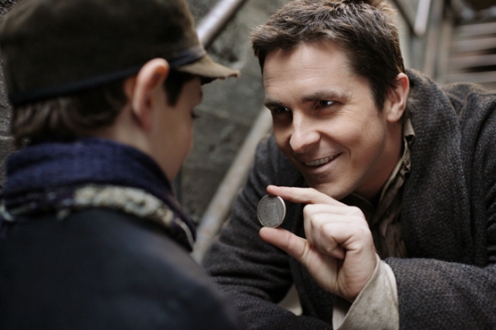
Things may not be what they seem: a labyrinthine play of mirrors provides structure to Christopher Nolan's 2006 film 'The Prestige.'
Such progressive mutation is part of the very fabric of the world in his later film Existenz. In Existenz (1999), there are multiple iterations of characters, scenes, actions, objects. This film as video-game about a video-game tracks the serial aspects of our contemporary world like few others. Here the video-game system which serves as the central conceit of the film serves as a device whereby to explore forms of fragmentation that speak to our contemporary life world. One could imagine such a film without the video-game device, and we should not think this would make the film better or worse, merely different. But we should also realize that if we extract the ways in which such a film deals with iteration as such, this becomes yet one more tool to be used in cinema, whether or not we justify by means of plots devices such as extremely powerful video-game consoles.
No longer should we have to ask whether or not a cinematic technique is allowed, but rather, what it produces. Why not have all the objects in a film evolve in this manner, or reflect aspects of the character? Why not change the objects in a film to reflect aspects of the action? We see some aspects of this in the manner in which directors since the begining of color film have coded some characters with a particular color of clothing, or matched the clothing of a character with that of an object in a room or aspect of a setting. Why not extract these tools and consider them all fair game? Whether or not we tie them to plot devices like time-travel or dreams is up to us, but we should acknowledge the power that mutating, multiple objects have on us today. In a time of iPhones and iPads, of objects that seem to feel and think, does it surprise us that our film-objects have become uncanny, multiple, powerful, labile?
PLOT
A plot is a series of events, and events are transformations in situations. A film begins, and a situation is laid out for us, composed of parts like setting, character, desires, etc. Minor actions may occur, but an event transforms the balance of entities and forces in a film-situation. A character shifts from being good to bad, the world is rocked by an earthquake, a murder occurs, the situation changes. These are events, and we string them together into plots.
And yet, in postwar film, we see how plots may not only be linear, but rather, may be a crystal of event-parts. Time-travel films, films of madness, science-fiction, films of the amnesiac, these films scramble the linearity of traditional plots. An amnesiac exists with no past, then slowly begins to remember, just like in our postmodern age we are so overloaded with narratives and information it is as if history has disappeared. We constantly need to reconstruct it from fragments, like the amnesiac. And in a world in which the past seems mutable, and the future composed in relation to such a past, doesn’t time-travel speak to the way we feel living in the present, wondering how to change who we are so as to harmonize our now seemingly multiple pasts, presents, and futures?
By means of films of time-travel and amnesia, as well as films with similar temporal structures composed of loops and other figures beyond the straight line, we have staged what it feels like to live in our postmodern age. Seeing our uncanny double stealing our memories speaks to us more vividly, in the age of Facebook, than a cowboy shooting a bad-guy on a dusty plain. We need twisted plots in which we meet our own clones, and our clones are more real than we are, and then these clones produce clones which turn out to be amnesiacs. In a hall of mirrors, which Deleuze calls the crystal-image, before and after becomes relative, and time ceases to be linear, but is more like a knot, gem, or four dimensional sculpture.
Only these sorts of films feel real to us today. This is not to wish for simpler times, for even clones can fall in love, or have radical politics. Evolution does not go backwards, nor should it. Just as uni-cellular organisms learned to work together to produce more complex life forms, humans can work together to produce transvidual entities, like language, or Wikipedia. And increasingly, this is becoming the rule, transindividuality is a radical series of new potentials for our future, even if it can also go radically wrong. Like all futures, there is great potential for good or bad. And we must learn new forms of love and solidarity for fragmented times. We live in an age in which we are all time-travelers, schizos, amnesiacs, space-travellers, if metaphorically. The question is not about going back, but learning how to make the new world livable, ethical, and just.
For as the digital age has fragmented everything it has touched, unleashing potentials for radical good and bad, so cinema must respond by finding new languages of fragmentation which speak to the needs of the times. Why must a plot follow a main character? Why not follow instead the permutations of a unifying phrase? We long to see dynamics and change, this is how a plot hooks us, we learn a situation, then we become curious to see how it will develop its potential for change. But we need not follow the old plots based on traditional characters overcoming traditional obstacles.
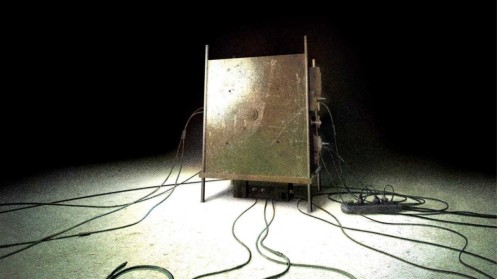
The time-travel machine from 'Primer': Strands of time emerge in many directions, or, does the same device simply ingress in multiple moments in time?
Take once again a film such as Mullholland Drive. The pull of curiosity that keeps us glued to this film is not the overcoming of some pre-established obstacle, but rather, to learn how the film will eventually cohere from the set of fragments which have been presented to us. What a better way to hook to the desire of a spectator to a film? Curiosity about the structure can supplant the traditional form of narrative plot. And just because the characters blur and fade into each other doesn’t mean we don’t care about them. The scene in the middle of the film, in which the singer on the stage collapses, is one of the most powerful in the film, and yet, we see this character for only this scene. We need to understand the power which such suspended moments, outside linear plot, can present to us.
A film is nothing more than a collection of film-elements composed so as to create a whole. Film-elements unify to form film-situations, and these are modified by film-events which link up to form film-plots. But these plots need not be linear, they can be looped and twisted via strands of time, moving forwards or backwards or something more or in-between, creating spatio-temporal short circuits in a wide variety of ways, blasting events open as they are criss-crossed multiple times by plot lines and become multiple. And as characters, objects, and settings multiply and mirror each other, short-circuits are produced, in which the very continuity of any object, character, or setting can be seen as a repetition laden with difference in a film which is fundamentally crystalline, providing multiple pathways in time, of which linearity is only one option amongst many.
Or perhaps we could even say that the same entities, objects, time-travelers and time-travel machines, perhaps stand still, and ingress in multiple moments of time, dipping into multiple strands of time like one would dip a toe into a stream? Might repetition from one perspective be multiplication from another? Many scientists have argued that perhaps there is only one photon, one light particle, in the universe, which simply bounces between many moments of spacetime. Why should film not be as strange as our realities?
And even as objects, characters, and settings may repeat, why not even events, with or without a justificatory device such as time travel? Bergman first did this in Persona (1966), when we see the same discussion from two different perspectives. In ‘the real world’ this cannot happen, but in the film world it not only can happen, but in this film, it must happen, for we see the conversation from two different sides, the two sides whose uneasy difference-in-sameness, sameness-in-difference, is precisely that which is investigated by the film. And in Bergman’s film, we are never quite sure at which point the film actually veers off into memory, fantasy, or dream, for in fact, the point of departure is multiple. The film does not suffer from this, but rather, is infinitely stronger. For this very multiplicity is precisely the film-world which Bergman wishes to create, and which gives the film its power, that speaks to the increasingly multiply fantasmatic nature of our times. Our lack of ability to pin-point, as viewers, the boundaries between dream, fantasy, and reality in this film, all this mirrors the inability of these characters to distinguish themselves from each other. The film is a complete, interdependent gesture, and yet, it moves beyond the limitations of traditional film. Persona is a clear precursor to a contemporary cinema of affects.
Or, take a film in which there are even three takes on an event. Kurosawa’s Rashomon (1950) presents us with three takes on the same incompossible set of events. Unlike Persona, we cannot simply see the film as two views of the same events, for these events cannot exist in the same world together. For Deleuze, a film like this is one of the earliest examples in film of what he calls the powers of the false. And beyond this, we can even imagine a film which is little more than a series of modifications of the same event (ie: the interruption of dinner, in The Discreet Charm of the Bourgeosie, 1972), such as we see in many of Bunuels later films.
Are these films any less powerful for being tangential to the so-called real world? For what could be more true to the reality of the period right after WWII than people who had seen the same reality, but seem to have read its meaning so radically differently? Rashomon expresses the disjuncture within reality that was part of the post-WWII age. And what expresses the futility of routine in the age of industrial capitalism, with its creepy mechanizations, better than Bunuel’s absurd comedies? Life under mechanization is like a dinner party that can never come to fruition, even as it repeats its failure once and again. Comparing industrial production to dinner, this is metaphor, the very stuff of artistic creation. It is what transforms the world into film-world, and creates affects. Of course, Bunuel’s film may be about much more than dinner, or industry, and here we see the polyvalent capacities of metaphor. But either way, we see how a plot can be non-linear yet potentially speak more powerfully to us than linear plots could.
Or take a more contemporary film, such as Sean Caruth’s time-travel film Primer (2004). As multiple characters start to travel backwards in time, producing a doubles of themselves each time, the world begins to proliferate with doubles which emerge from the future, with knowoledge of what is to come, trying to change the past. In an age in which we can see copies of ourselves recorded on digital film or video from so many different points in our lives, always looking different than we remember, might this film be more real than ‘reality’? And yet, this film is ultimately about more than just time travel, for it pursues the dissolution of trust between the protagonists in and through the use of time-travel, a world like the multiplicitous world of the present, in which selves multiply faster than we can keep track.
We see a related trope in The Prestige (2006), Christopher Nolan’s mind-bending film which may or may not involve a machine that makes copies of people, or people who simply learn very skillfully to disguise themselves as one another. Which is it? The film pushes indeterminacy to the limit, as doubles proliferate. Pairs, series, lines, solids of reflections and refractions.
But is this not closer to what it feels like to be alive today? For are there not so many people like us in the world, our doubles and triples? Variations on a series of themes? Might it not be possible to find someone else with nearly the same Facebook profile as you, who likes the same music, the same books, the same politics? The world multiplies permutations on a series of themes. And in today’s multi-mediascape, might we not encounter our doubles or triples at some point? Can we trust them? And can my favorite novels trust the favorite movies of my close friend that I’ve known for years?
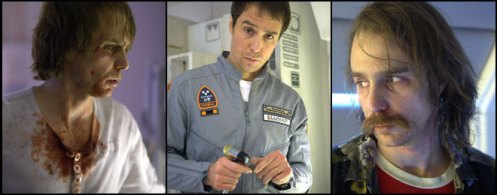
Even clones can have trouble recognizing themselves: three faces of the same, Sam Rockwell in Duncan Jones' 2010 film 'Moon.'
Or take a film like Moon (2009), by Duncan Jones. This film is able to produce intense feelings between two characters who slowly come to realize they are each other’s clones. The plot of the film is wound around a repeating cycle of birth and death lived by new clones in succession, until two of the clones accidentally end up in the same place at the same time, figure out that despite the changes one has gone through that they are ultimately multiple iterations of the same person, such that one of them then tries to get out of this loop. What type of plot could be more real than this in today’s postmodern times?
Such a film is more truthful, more real, than anything contrived plot of a film up for an Oscar this year, a film with a plot just like the others. Such films are the real clones, zombies that drain our potential for what’s realer than real. As Slavoj Zizek has argued, what is truly real is the fantasies which determine the ways we imagine our relation to the world. On such a level, films like Moon or Primer are infinitely more real than a film like The King’s Speech (2010). Such films pretend to depict so-called ‘reality’, and yet what they really depict is tired old genre conventions repackaged in new clothes. And yet, if reality is not these genre conventions, and never was, why do we cling to them so strongly? These are yesterday’s fantasies, we need those which speak today. While nostalgia has it’s place, if we want to understand the future and present, we need more films like Primer and Moon, not The King’s Speech.
To the cinema of affects, therefore, rather than ask whether or not the plot of a film is realistic, we should ask, what affects does it send into the world? How does a film make us feel, make us think? We do not need to have easy answers for these questions. But a good film will make us feel and think much, and we limit ourselves unnecessarily by relying upon the outdated unities of character, plot, object and setting to do this.
Some films may continue to use devices such as cloning and time-travel, and be strong because of this, but some films may eventually dispense with these devices completely. Either way, so long as the film is structured around the affects it creates, rather than correspondence with outside criteria, it is an example of the cinema of affects.
SETTING
What is a setting in a film? A background upon which unifying perspectives and functions and events and plots intertwine and unfold. Why does a character have to open a door and end up in the next room? Film has freed us from this need. Why not end up in the same room as one started in? Or in a forest? Just as we need to realize that plot and character are artificial unities when it comes to film, so it is with setting. Why does the same room need to always have the same furniture? Why not change it to fit the mood of the scene or the characters?
This is not to say such shifts are necessary. But they are possible, and whether or not we develop a plot device to justify such shifts (the character is insane, the character is dreaming) is up to us. A film which uses such shifts continually may be called magical realist or dreamlike, a film which never uses them may be called traditional, and those in between, that use such shifts highly selectively and in relation to highly constrained criteria might be called fantastic (ie: a quantum fluctuation machine creates transportation between locations, but only the machine is able to do this). These three forms are all modalities of filmic creation. For a cinema of affects, these are all tools in the toolbox, tools which may be used depending upon their ability to create affects.
Of these, films of the fantastic, ones which take aspects of the dominant so-called ‘reality’ and warp them or modify them in various ways have perhaps the greatest potential for the cinema of affects. For example, in a film like Tarkovsky’s Stalker (1979), we see an ordinary industrial wasteland transformed into an alien landscape, simply by means of camera angles, and the strange tale told by the character known as the Stalker. His belief is transferred to the other characters, so that it becomes difficult to tell whether this strange landscape truly has powers in the film-world, whether there is a mass dream or hallucination of sorts, or whether the Stalker is able to influence the minds of the others by the sheer power of his belief. Either way, the setting feels completely. A set of weeds become incredibly dangerous, full of hidden powers, such that rituals are needed to cross them without disaster occuring. An ordinary doorway in a room in an abandoned building becomes the site for the deepest wishes and fears of the main characters to come true.
Or take a film like Kubrick’s The Shining (1980), in which one can open a door and see a forbidden sexual act from the past. Such a spatialization of time transforms setting as much as it transforms plot. For example, as Deleuze has argued, we see such a device employed in Resnais’ Last Year at Marienbad (1961), in which the multi-doored hotel room spatializes time, each room holding what Deleuze calls separate ‘sheets of the past,’ even as the characters seem to jump between points of the present which never seem to line up with each other into a coherent flow.
When setting is loosed from the stabilities of the so-called ‘real world’, vision is liberated with it. The cinema of affects shatters the world to bits. And so it aims to suspend us before what it presents to us, to suspend its viewers judgment, so that they cannot know upon first viewing what it is they see and hear. In so many films by Tarkovsky, for example, we only learn what it is we see early on in the film once we have gotten to the end, for it is only at the end of his films that we begin to understand the lenses through which we are supposed to understand the opening segments of his films. And thus, we find that while we see and hear in the early parts of his films, he teaches us what it is to see without seeing, hear without hearing, or rather, to see and hear without knowing WHAT one sees or hears. Where does one divide between parts and wholes, foregrounds and backgrounds? Which aspects will be significant later? Nature in Tarkovsky’s films seems to pulse with hidden powers, powers to give birth to the racically new, and unleash within us a second sight, a multiple-sight of radical becoming. Tarkovsky is the prophet of a radically secular religiousity of the visible world. More than anyother filmmaker, Tarkovsky has taught us how to see differently, and most powerfully, to see nature differently. Never has an earthly landscape seemed more alien than that depicted in the opening scenes of Solaris (1972). And after the first viewing, never has nature seemed to be more than it was, a vision beyond vision, a vision made radically multiple, its productivity lurking between the strands of reeds, blades of grass, a holiness beyond any religion, a holiness of this world. Tarkovsky releases more than any other filmmaker the power of the film-world to transform everything. His settings are allegories for the radical power of film.
A cinema of affects must learn from this, it must seeks to suspend knowledge for potential, to show viewers the potential for worldmaking within each and every shot, within ever bit of sound and vision. As Tarkovsky has said, we must feel the pulsing of time in every shot, and if we read this through Deleuze, we can say that we need to be able to see the power of pure difference within each shot, for difference and becoming (not to be confused with more tame forms of time) are two sides of the same. Tarkovsky presents us with a pedagogy and a prophecy in his films, in which each aspect of each image has the potential to give birth to film-aspects and film-worlds to come.
So it often is with the films of Lynch. Time invades the very atoms on the screen, for you never know where it will make a cut in reality from the future, which aspects will become meaningful in retrospect, often not due to one reversal, but perhaps many. Or what of Memento, in which every ten minutes our relation to the past reworks? Or a film like Nolan’s The Prestige (2006), in which there are so many plot reversals, that each time we thought we understood how to read the past, things are once again reshuffled, until we learn to navigate the plot, as well as the relations between objects and characters, in a mode of radical suspension which opens us onto the power of a radical futurity in the present. All of these powers of film need to serve as raw materials for a cinema of affects.
-more to come!-

